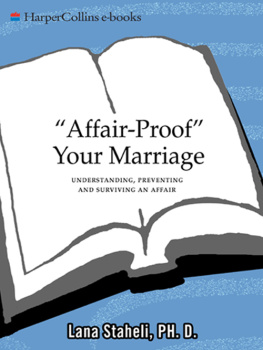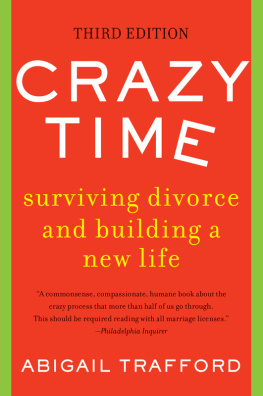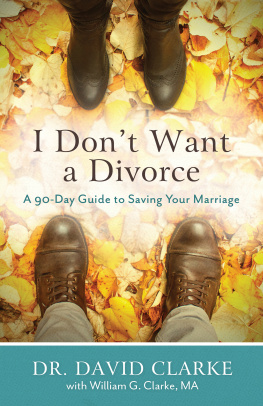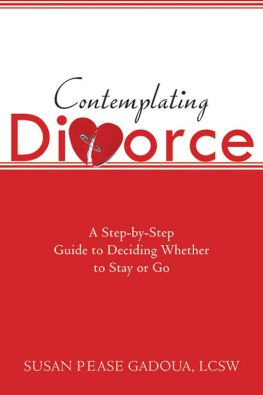How to Know
If Its Time
to Go
A -Step Reality Test for
Your Marriage
D R. L AWRENCE B IRNBACH
AND D R. B EVERLY H YMAN

New York / London
www.sterlingpublishing.com
To Marlo and Rachel:
Our love for you inspired us to ask the questions
that led us to write this book.
Authors Disclaimer
The advice in this book is written from a general perspective. It is not meant to be specific to any readers particular situation. It is most definitely not intended for any person to take specific action to end their marriage. It is intended to encourage the reader to recognize the issues that may be contributing to his or her problems, to discuss these with his or her spouse, and to seek professional assistance if it is indicated.
Many wise researchers agree that in researching the literature on marriage and divorce it is possible to find evidence that will support quite different points of view. We believe we have sincerely presented the current body of work reported by many of the most highly respected researchers in the field. Our emphasis is on what we believe to be the underreported parts of the research.
The people we write about in this book are all real. Their stories are true. The details have been altered to protect their anonymity.
Learning to live with a person you do not love and respect, learning to live with a person who neither loves nor respects you, is merely learning how to die, how to walk around as a shell, how to deny how you feel, how to hate without showing it, how to weep without tears, how to declare that the sham you live is the true reality and that it is good.
Jules Henry
CONTENTS
W e thank our great friends Jutta Sayles and Jules Kramer, who believed in us and our project, even when we were faltering, and used their networking magic to connect us to the right people. You were the catalyst that made it happen. We thank Jane Wesman, President of Jane Wesman Public Relations, Inc., who recognized the projects potential and connected us to Al Zuckerman, our savvy and wise agent at Writers House. Thank you, Al, not only for selling the manuscript, but for first helping us to better understand the book we were trying to write. We thank our three editors at Sterling Publishing: Meredith Hale, for convincing Sterling to take the book and for her wonderful editorial input; Tricia Medved, for picking up where Meredith left off and contributing additional wonderful editorial support in her own right; and Barbara Clark, for ushering us through many important aspects of finishing a manuscript. We also thank the interviewees, patients, relatives, and friends who generously contributed their stories so that others might benefit from their openness. Your candor and your need to be understood invigorated us and reinforced for us that we were on the right track.
I t was 3:30 a.m. when Ann looked at the clock next to her bed. The alarm was set for 6:30, but her sleep had ended, as it often did now. She lay quietly next to her sleeping husband. She had been dreaming of being locked in an empty house. The dream reminded her of her empty relationship and the growing sadness that she had felt during the last five years. She thought of the previous evening, the dinner she had cooked, and then waited to share with Frank, his kiss on her cheek when he came home at 8:00 oclock, the meal they ate mostly in silence, followed by his quick retreat to the den to make business calls. She felt like crying, but only let out a sigh so as not to wake him. He was irritable if she woke him in the night, even if she was upset or frightened.
Ann recalled how she had driven past her exit on the highway yesterday, the second time shed done that recently. The nightmare image of being locked in an empty house came back. She imagined just leaving everything and running away. Instead, she rolled onto her side to try to go back to sleep. Ill be thirty-eight next month, she thought. This is my lousy life.
The middle of the night is often a difficult time for the millions who are in unhappy marriages. They may be Anns age, younger, or older. They may be men or women. They wake in a fitful state, and their thoughts go around and around with feelings of sadness and anger and fear, and wishes of what might have been or could be. They picture themselves with other partners, or compare their marriages and partners with others. They worry about their children, their finances, and how their lives are passing them by, with little hope of change. They ask themselves over and over: Should I divorce? Do I have the courage? Can it ever get better? Will the children be okay if I get out? Will I be okay? Will I be alone forever? Can I afford to go? Can I endure if I do not? Do I stay in a deeply dissatisfying marriage? Is there any hope of change? Are the rare good times a sign that we still have something together? What do I face if I divorce?
At one time or another, much of the adult married population has thought about these questions. Since 40 percent of the marriages in the United States end in divorce, many people spend a lot of time thinking about them. Many who cannot bring themselves to divorce are also plagued by these questions, but stoically persevere in desolate marriages. And many think about them, but ultimately decide the good outweighs the bad.
We do not advocate divorce, but, while a happy long-term marriage is certainly most desirable, this option is not always available or possible for many couples. At least 2.5 million American men and womenand more than 1 million childrenlive through divorce each year. We can safely assume that these people, as well as the millions in unhappy marriages who choose to stick it out, wrestle at length with the questions we raise.
Ten Steps to a Decision
The fears surrounding divorce are the same for almost everyone. This book provides ten steps to help you examine how serious the problems are in your marriage, what you might try to do to improve it, and, if thats not possible, considering whether its time to separate and divorce. It presents the best research and personal examples about divorce drawn from twenty-five years of counseling individuals and couples, as well as scores of interviews conducted for the book. Whether you decide to stay and try to work it out, or go, this book will help you formulate a step-by-step, concrete plan for action.
Just as important as facing your fear of divorce is understanding the high cost of the alternative to divorcecontinuing to live in an unhappy marriage. This book will provide you with guidance on whats important to make your marriage work better, and what steps to take to figure out if yours cannot.
Here is a summary of the steps we will discuss in detail throughout the book:
Determine: Is my marriage unhappy? How unhappy am I?
Ask yourself: Is our parenting faltering?
Look at your children right now: Is our unhappy family affecting their school performance, behavior, and self-esteem?
Face the truth: What is the quality of our sexual life? Have we maintained emotional intimacy in our marriage?
Assess: Is marital stress affecting my physical and mental health? My childrens? My spouses?
Take an inventory: What are my fears about separating and divorcing? What stigma and shame do I fear from my family, friends, religion, and community?
Evaluate your situation realistically:
Next page





